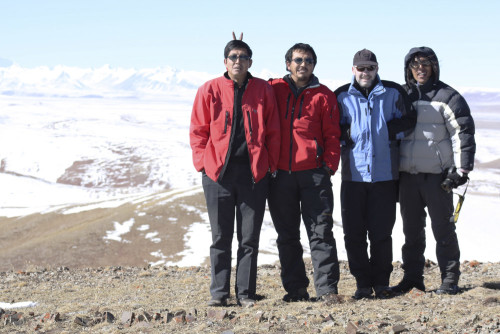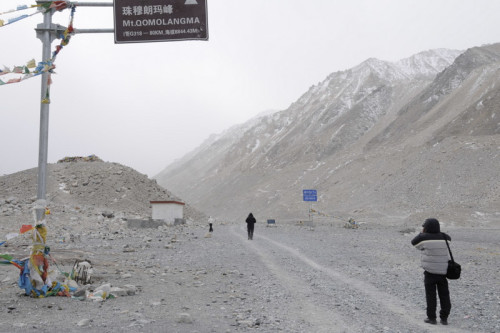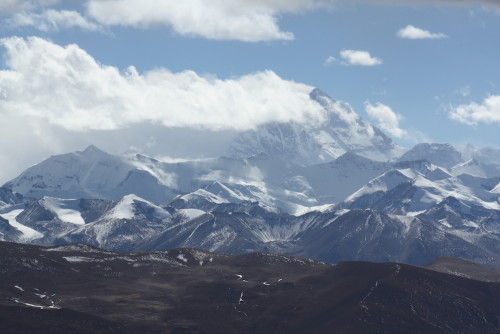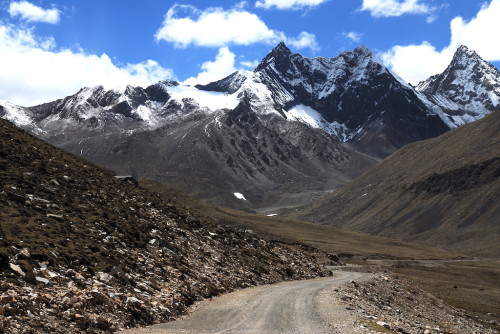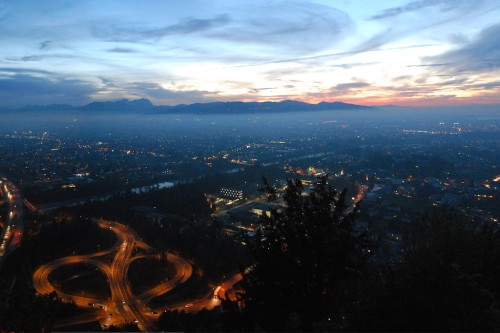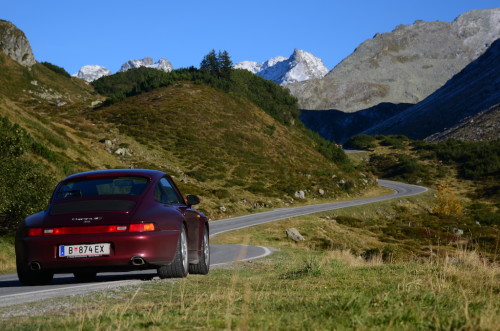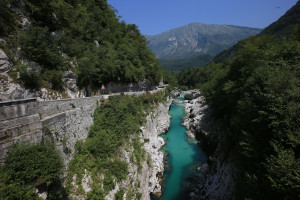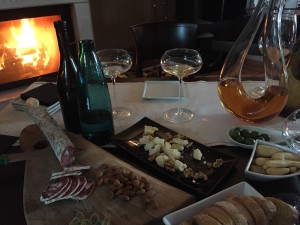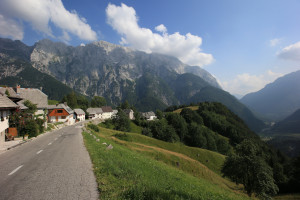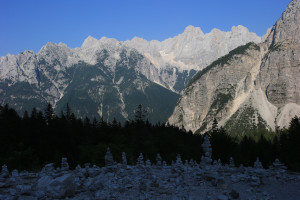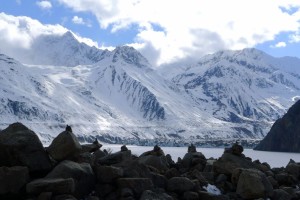Tag Archives: Tibet
Posted on 10 May, 2016
In November 2010, Peter and I spent a few weeks in Qinghai and Tibet researching new itineraries – routes that became Roads on the Roof of the World and the Qinghai version of Tibetan Highlands.
We had enjoyed an adventurous start to the trip, including an attempt (quickly abandoned) at winter camping in Tuotuohe, and what must have been one of the longer picnics in Qinghai’s history as we waited for an over-ambitious lamb stew to cook 5,000 metres above sea level. But, as we arrived in Lhasa, fatigued but at least thoroughly acclimatised, the trip’s highlight – Mount Everest – still lay ahead.
After a few days in Lhasa, we set out for the mountains. As we drove west of Shigatse, human settlements thinned out dramatically and the landscape grew steadily more otherworldly. Bands of ochre sediment jutted out at strange angles, hinting at the violence of the collision that forced the Tibetan Plateau three miles into the sky – and pushed the mountain peaks higher still. Eventually, we came to Baiba.
Baiba is a rugged little town that sits beside the highway to Nepal. Nobody would choose to stay here, except for the fact that it is conveniently close to the turn-off for Mount Everest’s North Base Camp. We stopped here one evening, four days out from Lhasa. After looking at hotels and restaurants and an hour spent sitting wrapped in blankets, talking and playing cards by candlelight, we called it a night.
The following morning our alarms rang well before dawn. Bundled up like onions in thick layers of clothing, we loaded the cars and set off. The beginning of the journey was stop-start as we passed through checkpoints and turned onto the gravel road (now paved) to Base Camp. As we climbed through a long series of switchbacks, suspense grew. We were climbing up to Pang-La, the first pass from which Everest is visible – would the peak be clear?
I was sitting in the first car in our two-car convoy. As we crested the pass, I used the walkie-talkie to report, incisively, that, “Oooh,it’s beautiful!” Dawn had painted the smaller peaks with a rosy glow, and there was a gorgeous arc of white-capped mountains before us. But the larger peaks were shrouded in thick cloud, as we used a signboard to work out where Everest, Lhotse, Makalu and Cho Oyu ought to be.
It is a long drive from Pang-La to Everest, and it seems even longer when you can’t see the mountain in question. We drove on in hope that the weather would clear, but the mountains stayed locked in behind the cloud as the morning wore on. Early that afternoon we arrived at a deserted Base Camp and scrambled up a huge and crumbly lump of moraine that is used as a viewpoint when there’s something to view. A wall of mist swirled before us, as we tried to imagine how huge the mountain would be at such close quarters.
Eventually, even Peter – usually the most optimistic person in such situations – conceded that we might as well turn back. So we turned around and began to drive back to Baiba, disappointed and empty-handed, for we had hoped to come away with some photos of Everest for our new journey dossiers. Seeing Everest was one of my top travel ambitions, and it seemed such a pity to have been to Base Camp without getting so much as a glimpse of the north face.
Late that afternoon, as we were climbing back up to Pang-La, my car’s walkie-talkie crackled into life. “I think the clouds are clearing,” came the message. And they were. One by one the mighty 8,000 metre peaks emerged, looming twice as high and more massive than we’d imagined. My disappointment evaporated and – just as suspense had mounted that morning – excitement began to mount as we zig-zagged back up to the pass.
Since that first trip I’ve had brilliant luck with the weather in these mountains. And while it’s an incredible experience each and every time – I always end up gazing at the highest peaks for minutes on end – nothing compares to the thrill of that first sighting. The clouds never completely cleared and we only had a short while before the weather closed in again, but it was enough to create an indelible memory of just how magnificent our world is. And that is the point of travel, is it not? Well, that and being able to say you’ve eaten lamb casserole at 5,000 metres above sea level…
Posted on 5 Mar, 2016
For most people and much of human history, mountain passes evoked visions or memories of anything but pleasure. Instead, they were associated with the pinnacle of hardship as traders, exhausted and starving, struggled to carry their wares across mountain ranges wrapped in deep snow and whipped by ferocious winds. Or they were frozen graveyards of soldiers since mountain ranges formed natural boundaries turned political borders. Mountain passes were the places where one came face-to-face with the enemy and the violence of war.
How different my world is. I grew up in the heart of the Alps and in a period of peace and unprecedented wealth creation: there are fabulous roads to drive across the Alps and the only enemy I recall encountering at the top of a mountain pass was a bird that shat into my open-top car while I got myself a grilled sausage from a stand by the roadside.
According to one website for motorbikers, there are over 300 mountain passes dotting the Alps. I must have driven across at least a third of them, including some of the highest, like the Col de la Bonette in eastern France.
(When I drove across this one many years ago I felt quite proud, though I’ve since driven over a mountain pass on the S304 in Tibet that’s early twice as high, topping out at 5,450m.)
Once, on one day alone, I crossed fifteen Alpine passes. On days like these, when I have the luxury of driving for fun, the agony of waking to the sound of an alarm clock in the early hours of the morning was almost instantaneously replaced with eager anticipation of the treat to come. In no time, I was up, dressed, had put on my soft driving shoes (all the better to work the pedals), and had rushed out to my car.
On that morning I started off in Bregenz, an Austrian town by Lake Constance. At first, with the early morning temperature hovering around five degrees Celsius, the car’s engine was still cold, not ready to be put through its paces. The engine spluttered and vibrated edgily in its compartment. But by the time I reached the city boundaries, heading south, it was purring and I was raring to go.
When the last of the city’s stop-lights turned green, it threw open the road before me. I sped up and found myself rushing toward immense beauty: the black, purple, pink and orange of dawn in the Rhine valley. There was the instant thrill of being pressed into my seat, feeling the engine coming, then coming again, and again, as I shifted through the gears. It was a sensation of total immersion and bursting free, both at the same time.
About an hour later, the sun rose and divided the world in two, the still-dark valleys below and the glorious mountains above. In fact, I had finished climbing the first mountain, the Bielerhöhe, which separates Austria’s two western-most states, and was already descending into a Tyrolean valley, negotiating hairpin turns on the way down, one after another.
The only way I can describe driving among those mountains on that day is as a sensation of near-flight…
Come back for the continuation of On days like these … soon…
Posted on 26 Jan, 2016
This Easter, we will return to Slovenia for the second time in as many years. Yet until 2015, I’d hardly heard the country’s name, despite growing up in neighbouring Austria. Suddenly, Slovenian connections seem to be emerging all over the place.
|
When I was growing up in Austria in the 60s and 70s, Slovenia was part of Tito’s Yugoslavia and lay behind the Iron Curtain. In my imagination, anything connected to the USSR was rendered in monochrome – inaccessible, undesirable, and forbidden. Why would anyone want to go there? I never had cause to reconsider this attitude until about a year ago, when my wife, Angie, and I began planning a trip to Croatia. Angie, who is originally from Malaysia, mentioned this casually to her sister Denise when visiting her last year in Melbourne. “You’re going where?!” exclaimed her sister. “Croatia’s right next to Slovenia. My best friend is from there.” Thirty minutes later Denise’s friend Renate had joined us to tell Angie all about Slovenia. |
A few facts about Slovenia…
Slovenia is a small central European country with a population of just two million. Part of the Austro-Hungarian Empire until it became independent at the end of World War I, Slovenia shares Austria’s mountainous geography. Since joining the EU in 2004, Slovenia has become a moderately well-to-do and modern country, yet has retained a rustic and unspoiled charm. Slovenia produces wonderful wines (mostly whites but also reds) and has endeared itself to us for family restaurants that serve hearty food “like grandma used to make”.
Several of our On the Road in Europe itineraries visit Slovenia (for example, this itinerary here). In 2017 we will be launching an Eastern Europe itinerary that will include the Czech Republic, eastern Austria, Slovenia, Croatia and Northern Italy. |
“If you do go to Slovenia, I’ll introduce you to my cousin Sanja. You can stay with her!” Just three months later Angie and I met Sanja and her husband Davorin. The couple live and work in Slovenia’s largest national park which takes its name from the country’s tallest mountain, Triglav. Sanja works in a drugstore; Davorin’s work is connected to the national park authority. They have three sons who could be the envy of any parent: courteous and lively, they come home from school to work on the family farm without their parents’ prompting. Much of what the family eats comes from their own land.
After Angie’s meeting with Renate, our trip to Croatia expanded to take in Slovenia as well. While researching our itinerary we thought it
would be nice to stop at some vineyards along the way. A friend recommended Movia, one of Slovenia’s finest winemakers. The vineyard’s owner, Ales, is one of a kind, we heard. Wouldn’t it be something to meet him?
When we plan our holidays, Angie researches the hotels and restaurants; I pick the roads in between. On February 10th last year, we pulled up in front of one of Angie’s selected restaurants, Danilu, on the outskirts of Ljubljana and a member of Jeunes Restaurateur d’Europe. We were served by a fizzy young lady who turned out to be the owner’s daughter. Besides helping out in the family restaurant, she runs a night club and, to our great surprise, counts Movia’s owner Ales among her close friends. A week later we met Ales, shaking his enormous farmer’s hands, and spent an entire afternoon tasting his beautiful wines in his firelit tasting room.
Sinuous roads lead through the Triglavsky park – one, narrow and steep, leads across a tall pass from Kranjska Gora to Soca; another enters from Italy. Less winding, the latter meanders across a lower pass and traces the course of a beautiful river. I could drive on these roads for hours without getting bored: how could one when immersed in this lovely landscape and dreamily following the curvy tarmacked ribbon of road?
We were driving through Triglavsky National Park earlier this year when I suddenly noticed something I hadn’t seen for a while. It was one of those double-take moments: did I just see what I saw? I turned around and back-tracked and then stood in front of, well, was I still in Slovenia? Or had I been transported to Tibet? Right there, in front of me, there were little cairns of stones that I had last seen along the road to Mt. Everest: sacred piles of stones that are constructed to fend off evil and bring good fortune. How had they been transported to Slovenia?
I find myself pondering how it can be that I had to go from Austria to Tibet and then via Malaysia and Australia only to discover Austria’s neighbor Slovenia and its unfathomable connections to places impossibly remote from it.
Sometimes it’s the things planned well in advance that make a journey special, like Angie’s restaurant choices or a particular route I’ve chosen, but at other times it’s the magic of serendipity – a chance collision of people and places – that transforms a journey into a really exceptional experience.
Posted on 23 Nov, 2015
I want to write about Tibet, but I’m struggling with where to start. Should I begin by describing the raw beauty of the Himalayas? Maybe with the profound way that Buddhism permeates the Tibetans’ daily lives? Or perhaps I should start with the rigours that are inevitably involved in a journey on the Tibetan Plateau?
This forbidding region draws me to it in many ways, but it boils down to the following; the pursuit of adventure, a love of mountains, the challenge of overcoming adversity, and witnessing the Tibetan people’s devotion.
Above all, to me Tibet stands for adventure. In exchange for moving myself out of my comfort zone, I know that I will come home with unforgettable memories.
The photo shown here is from one of many such adventures, and taken on my 21,000km journey through China in a Caterham Super 7.
It was July 2007 and early rains had swollen a nameless river in eastern Tibet, sending it gushing across the road. Attracted by the odd sight of a yellow sportscar on this remote stretch of road, three passersby rolled up their sleeves and volunteered to help Miss Daisy (the Caterham) and I through the water. When you scream ‘push’ and three kind volunteers heave you through an icy cold river, you won’t forget it!
Beyond the thrill of adventure, there is the magnetic pull of the mountains. I grew up in the Austrian Alps and thought them magnificent – until I went to Tibet, that is. In Austria you reach sky at 2,000 metres above sea level. In Tibet there are cities with airports and golf courses at that altitude. The Tibetan highlands start where the Alps end, more or less. The plateau is, almost literally, quite out of this world.
But while Tibet’s mountains – from Mount Everest on down – lend the landscape an unparalleled drama and beauty, the region’s high altitudes also make plateau life and travel uniquely challenging. Lhasa’s iconic Potala Palace may seem an appealing place to visit on your first day in the Tibetan capital, but climbing the staircases to the entrance is best left until the end of your trip when you are properly acclimated.
Perhaps the Tibetans’ profound Buddhist faith is related to the challenges of living at such altitudes. Almost every time I find myself in the Tibetan world, sooner or later I encounter people making the arduous pilgrimage to Lhasa’s Jokhang Temple. Each pilgrim will prostrate themselves, get up, walk three steps, and prostrate again (in Chinese this is called 磕长头). This slow progress continues, not for a hundred meters, not for one kilometer, but for hundreds – if not thousands – of kilometers.
Weatherbeaten, dirty, exhausted, and yet with their broad smiles hinting at inner bliss, the pilgrims have retained a depth of faith that many of us have long since lost. I’m not a religious man, but I never fail to be moved by others’ devotion. Add to this the outer trappings of Tibetan Buddhist ritual – monks chanting by flickering lamplight, prayer flags snapping from mountain passes and timeless festivals – and this is clearly one of Tibet’s many attrations for me and many others.
Some places offer one of these drawcards, perhaps one destination offers mountain adventure, while another posseses a unique culture, say, but few offer such a beguiling combination as the Tibetan Plateau. It is small wonder that this special place has attracted generations of adventurers and romantics…
What is it that draws you to Tibet?
* * *
If you agree with me about Tibet’s many and varied attractions, you might like to read more about our upcoming Tibetan journeys.
Mountain-lovers will be interested in Roads on the Roof of the World, a fantastic 8-day itinerary that runs from the Tibetan heartland to Mount Everest Base Camp. The 11-day Tibetan Highlands is an epic journey from Kunming to Lhasa overland across the beautiful and rugged eastern foothills of the Himalayas. Both will have departures in spring 2016.
Posted on 16 Nov, 2015
My mind wanders terribly. While I might look as though I’m sitting at my desk or riding the subway, in my head I’m watching crowds celebrate Saga Dawa in Gyantse or cycling across New Zealand’s Southern Alps – remembering long-ago trips and planning future travels.
While I’ve always thought of these daydreams as being one small step away from procrastination, recent psychological research shows that by reliving fond memories and anticipating future experiences I’ve actually been enjoying one of the few ways in which money can buy happiness.
The relationship between money and happiness has long been a source of debate. Reams of psychological studies have been produced on the topic since the 1970s, when a group of Californian academics discovered the Easterlin paradox – that money does make people happier, but only up to a point. Once our basic needs have been taken care of, it seems that it’s up to how we spend any surplus that makes the biggest difference to our happiness.
Research has found that the best way to do this is to invest your money in experiences – whether that means concert tickets or cooking classes, the holiday of a lifetime or a daytrip – rather than material possessions.
Logically, buying something would seem to make more sense – a hi-tech watch or a beautiful book will be around long after an experience has ended, after all. However, this logic glosses over several facets of human nature, which combine to turn that thinking on its head.
For one thing, we easily take things for granted. It’s not long before we get used to a shiny new toy and it becomes part of the background. Our levels of happiness soon return to where they were before, a process psychologists call hedonic adaptation.
While material goods deteriorate with time – getting scuffed and scratched – the memory of a pleasant experience improves with age. Even a bad experience can become a good story with enough retelling and time, and in this way fleeting experiences can become an ingrained part of our identity in a way that a possession rarely does.
Apparently even the way we anticipate experiences and purchases is different. Psychologists found more positive interactions amongst people queuing for concert tickets than among those queuing to buy smartphones, for example. Waiting to buy a new gadget tends to fill us with impatience, rather than anticipation, as I’m sure many of us have found!
Instead of giving in to the desire for impulse purchases and instant gratification, we can wring more enjoyment out of spending our hard-earned money by planning purchases far in advance. As the saying goes, “anticipation is the greater part of pleasure” – especially when it comes to experiences.
Shared experiences also bond us to others in a way that a mutual preference for a certain brand does not. While owning a 4K TV might give you something to talk about with another 4K TV-owner, it won’t make for an instant connection in the same way that, say, having climbed a mountain together would.
So, the lessons seem to be: buy experiences, not things; plan far in advance to maximise the pleasure of anticipation; enjoy recalling past pleasures – and keep daydreaming.
To read more about this topic, visit:
The Atlantic: By experiences, not things
Fastco: The Science of why you should spend your money on experiences not things
